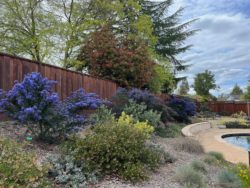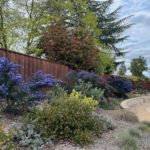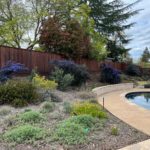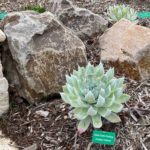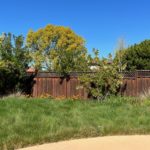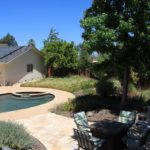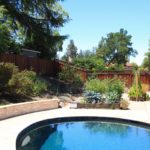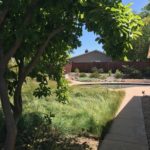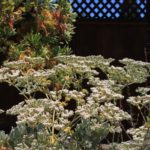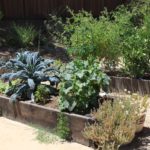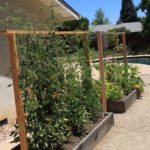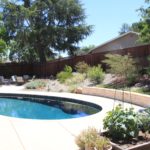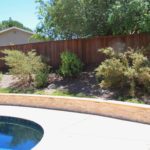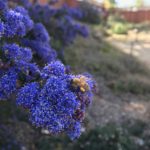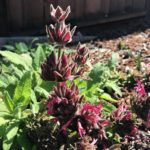Lot size: 5,000 sq. ft. back garden, 99% native
Garden Age: Garden was installed in 2019
Years on the Bringing Back the Natives Garden Tour: 2
Showcase Feature
Long-time Bringing Back the Natives Garden Tour attendees and avid hikers Maria and David wanted to “bring nature home” and make their own garden a haven for pollinators. Through the Tour they visited numerous gardens designed by Kat Weiss, owner of Kat Weiss Landscape Design, and knew she was the one they wanted to transform their garden.
They removed excess concrete and a dull, straight concrete retaining wall, replacing them with attractive, gracefully curving stone-faced benches faced that offer visual appeal and increase seating capacity, while also holding back the slope.
The non-native ornamentals that offered little to no value to wildlife went the way of all things, and were replaced with widely-spaced native shrubs, which give the landscape a semi-manicured look, and emphasize the spaciousness of this large garden. Eight types of manzanita and three kinds of California lilac, as well as coffeeberry, buckwheat, and sage provide greenery and stability throughout the year, and food, shelter, and places on which butterflies and moths (whose caterpillars are the primary food for baby birds) can reproduce.
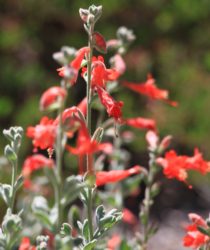 An attractive native “Mow-Free” bunchgrass meadow whose curving border echoes and complements the arc of the pool contains a trio of grasses; Point Molate fescue, Western Mokelumne fescue, and Idaho fescue. The deep roots of these perennial grasses help them tolerate Livermore’s hot, dry summers, while sequestering carbon up to twenty feet underground. (Did you know bunchgrasses were so deep-rooted? This makes them a great choice for erosion control.) It’s hard to believe this lush lawn is only watered twice a week for ten minutes each time. This three-fescue mix, which does well in full sun but can also be planted in areas with 50% shade, needs no mowing.
An attractive native “Mow-Free” bunchgrass meadow whose curving border echoes and complements the arc of the pool contains a trio of grasses; Point Molate fescue, Western Mokelumne fescue, and Idaho fescue. The deep roots of these perennial grasses help them tolerate Livermore’s hot, dry summers, while sequestering carbon up to twenty feet underground. (Did you know bunchgrasses were so deep-rooted? This makes them a great choice for erosion control.) It’s hard to believe this lush lawn is only watered twice a week for ten minutes each time. This three-fescue mix, which does well in full sun but can also be planted in areas with 50% shade, needs no mowing.
Drop down in one of the multiple seating areas and enjoy this peaceful haven.
Other Garden Attractions
• A compact veggie garden flourishes on the far side of the garden.
Gardening for Wildlife
Pollinator-friendly native plants invite wildlife into the garden. The bunchgrass lawn is visited by dragonflies, praying mantis’, butterflies and birds. Leaves and small branches are left to decompose on the ground, improving the soil and creating places for really tiny forms of wildlife.
Since the garden was transformed, a dozen types of native bees have visited the garden, as well as butterflies and moths. Bats fly overhead in the evening, snacking on mosquitoes. Black phoebes, chickadees, bushtits, western bluebirds, and cedar waxwings visit the gardens; a kite has been spotted hovering overhead and watching the action below with interest. 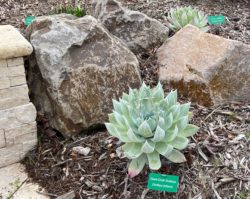
Keystone species in this garden Watch this talk by Doug Tallamy!)
Keystone species—our own, local ecological powerhouse plants— in this garden include California lilac, manzanita, currant, sages, and buckwheat.
At least partially wheelchair accessible? Yes
Green Home Features
Maria and David’s attic is newly insulated. Heating and cooling costs account for up to 50-70 percent of the energy used in an average home, so losing hot or cold air because of poor insulation wastes energy and money. The Department of Energy estimates that a properly insulated attic can shave up to 50 percent off your heating bill.
A 10-kilowatt solar panel system generates all of the energy needed to run the electric appliances in this household.
Since 2019, when the solar panels were installed, the Dawson’s electricity bills have been $0. In fact, each year they have received a check from East Bay Community Energy of between $300 and $800, compensating them for the excess energy produced by their panels that was sent to the grid. For their solar installation they received a 30% tax credit for the cost of the panels and installation. (With the passage of the Inflation Reduction Act, the Federal tax credit is once again 30% of the cost of the solar panel purchase and installation.)
In 2022 the Dawson’s replaced their gas furnace and old air conditioning unit with a heat pump that both cools and heats the house; they also installed a whole house fan. The house is now both heated and cooled by the energy created by their solar panels, at no cost to them.
The whole house fan takes advantage of our cool California summer nights by quickly exchanging the warm inside air with the cool outside air in an extremely energy-efficient manner. The Dawson’s use their whole house fan instead of AC for at least 9 out of 10 nights during the summer, significantly reducing their dependence on air conditioning while keeping their house comfortably cool.
The Dawson’s new roof—Solaris, by Certainteed—can reflect up to 44 percent of solar heat, reducing roof temperatures and heat transfer into living spaces (and lessening the workload of the heat pump) to keep their home cooler in the summer months.
Check out photos of the Dawson’s green home features, and find out what they learned through their experience researching and installing these systems.
Note that rebates for heat pumps need to be planned before installation through BAYREN and performed by a participating installer. For more information: https://www.bayren.org/homeowners/heat-pumps
Wondering what to make for dinner? Try this recipe, submitted by Maria Dawson
Zucchini Fritters, recipe from Bon Apetit


